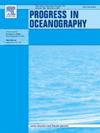温度和盐度对黄海沿岸硅藻和鞭毛藻动态的意义
IF 3.6
3区 地球科学
Q1 OCEANOGRAPHY
引用次数: 0
摘要
硅藻和鞭毛藻是浮游植物中两个典型的功能类群,在全球初级生产中占有重要地位,在生态系统过程和生物地球化学循环中起着重要作用。众所周知,海洋中硅藻和鞭毛藻的动态变化主要受与气候变化和人类活动相关的水文条件变化的驱动。然而,人们对它们适应不断变化的海洋环境的能力知之甚少,因此很难预测它们是否会适应以及如何适应。对黄海沿海地区(2021-2023)野外数据的分析表明,受季节变化驱动的温度和盐度变化对硅藻和鞭毛藻的动态影响显著。此外,这两组的季节动态对温度、盐度及其相互作用表现出不同的响应。具体而言,硅藻的耐热性高于鞭毛藻,但对盐度变化更敏感,通常在温暖、低盐的夏秋季节占主导地位。相比之下,鞭毛藻由于其营养策略,对盐度变化表现出更大的耐受性,在高盐度条件下往往与硅藻共同占优势。总体而言,温度和盐度的变化对黄海沿岸的硅藻和鞭毛藻有很大的影响,尽管它们之间的关系不同。因此,未来的研究应关注温度和盐度联合变化的长期影响,以及其他环境变量如养分有效性的潜在影响。本文章由计算机程序翻译,如有差异,请以英文原文为准。
Significance of temperature and salinity in the dynamics of diatoms and dinoflagellates along the coastal Yellow Sea
Diatoms and dinoflagellates are two typical functional groups of phytoplankton, which account for a major part of global primary production and play an important role in ecosystem processes and biogeochemical cycles. It is well known that the dynamics of diatoms and dinoflagellates in the ocean are mainly driven by changes in hydrological conditions related to climate change and human activities. However, little is known about their ability to adapt to changing ocean environments, making it difficult to predict whether and how they will adapt. Analysis of field data from the coastal Yellow Sea (2021–2023) showed that temperature and salinity changes, driven by seasonal variations, notably affected the dynamics of diatoms and dinoflagellates. Moreover, the seasonal dynamics of these two groups exhibited distinct responses to temperature, salinity, and their interactions. Specifically, diatoms exhibited greater heat resistance than dinoflagellates, but were more sensitive to salinity changes, often dominating during the warmer, less saline summer and autumn seasons. In contrast, dinoflagellates, due to their nutritional strategies, showed greater tolerance to salinity changes and often co-dominated with diatoms under high salinity conditions. Overall, changes in temperature and salinity had a large impact on diatoms and dinoflagellates in coastal Yellow Sea, albeit with different relationships. Therefore, future research should focus on the long-term effects of combined temperature and salinity changes, as well as the potential influence of other environmental variables such as nutrient availability.
求助全文
通过发布文献求助,成功后即可免费获取论文全文。
去求助
来源期刊

Progress in Oceanography
地学-海洋学
CiteScore
7.20
自引率
4.90%
发文量
138
审稿时长
3 months
期刊介绍:
Progress in Oceanography publishes the longer, more comprehensive papers that most oceanographers feel are necessary, on occasion, to do justice to their work. Contributions are generally either a review of an aspect of oceanography or a treatise on an expanding oceanographic subject. The articles cover the entire spectrum of disciplines within the science of oceanography. Occasionally volumes are devoted to collections of papers and conference proceedings of exceptional interest. Essential reading for all oceanographers.
 求助内容:
求助内容: 应助结果提醒方式:
应助结果提醒方式:


